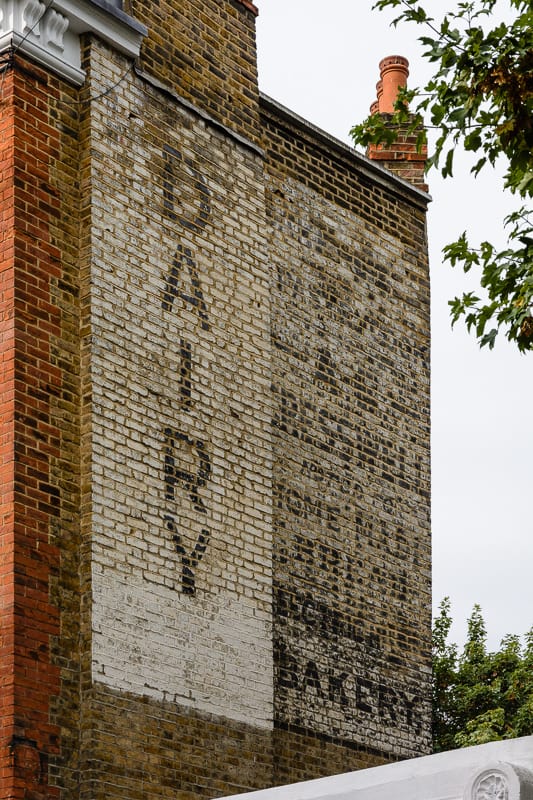15 Feb 2021
Are These London’s Most Elusive Trio of Ghost Signs?
In a recent blitz of London ghost signs research, these three have proved almost impossible to find out anything concrete, so I’m posting this in the hope that others might have sources or memories that can help unlock them. (For a couple of less beguiling mysteries, see recent posts on Peterkin Custard and the Perry & Son pawnbrokers.)

S. Louis & Co, French Place, E1
Comparing Maggie Jones’ 2009 photo with Roy Reed‘s more recent shot shows the S. Louis & Co. name has faded rapidly over the last ten years or so. However, the real intrigue here is trying to discover who S. Louis was.
The sign is found on French Place in Shoreditch, once home to a thriving furniture trade, but the exact street number isn’t clear. It is depicted without any contextual information in a publication about this former industrial centre. So far the clues I’ve found are as follows, none of which are conclusive evidence, but each offers up possible lines of further enquiry.
- 1920–25: Bertani Armand Louis, moulding maker, listed at 2 French Place. The B.A. initials don’t match up to our S, and nor is the trade quite spot on. Bertani could of course have been running a business founded by an earlier S. Louis, and shifted the focus of the firm’s activities.
- 1921: Louis Cabinet Co., cabinet makers, listed at 63 & 65 Rivington Street. Their time at this address was short-lived, with other cabinet-making firms there in 1920 and 1925. Likewise, the company itself isn’t listed elsewhere for these dates before and after 1921. It could have been a flash-in-the-pan affair, or have some relationship to the Louis under investigation.
- 1925–41: Semeta Louis (sometimes spelled Semetta), cabinet maker, listed at 70 Shaftesbury Street, N1. This is only a mile away, so it wouldn’t be too far stretched to imagine a move to or from French Place at some stage. The 1934–41 listings give the name as S Louis, with “L Semeta” in brackets and so we have a match on the business name, but with no apparent connection to the location in French Place. Given the dates, it is possible that there is a relationship between the above Louis Cabinet Co., and Semata’s firm.

Dairy | A.E. Cresswell, Bakery, Richmond Way, W14
This is an interesting ‘double’ with the signs side by side, although in very different styles. It would seem that they were contemporary to each other, with two businesses on the parade sharing the wall at some stage. The dairy sign offers no further clues, but the baker’s name was A.E. Cresswell, and an almost complete transcription reads as follows:
Baker & Pastry Cook
A.E. Cresswell
Noted for Home Made Bread
Electric M… [This can’t be read, but is likely Machine, or similar]
Bakery
The address of the building that hosts the signs in now 60 Richmond Road, W14, but this was called Richmond Way prior to 1938. It sits right on the border of the areas covered in the London and Surburban street directories, with the move into the London directories happening c.1896. However, until at least 1920 number 60 doesn’t appear in the directories, despite other numbers shown where they’d be expected on the street. This likely excludes a renumbering of the street, but I do think that resolving this conundrum would unlock the puzzle given the information that has been found after 1920.
At number 60 there are bakers listed from 1925, but none by the name of Cresswell. They are Stanley Herbert Lockwood in 1925 and Hedley Bakeries, a partnership between Olga Alice and Olga May Tompkins, for 1930–34. There isn’t a dairy explicitly listed so far, with the only possibly relevant business being the shopkeeper Thomas George Weedon from 1940.
Given the absence of records before 1925, it seems likely that Cresswell, and perhaps the dairy, would appear somewhere in those. It’s also possible that both signs post-date 1941, which is the most recent date to which I have access to directories.
Cresswell is the other clue on the sign, and there are bakers by this name listed elsewhere in London at various times. These are as follows, but I’ve been unable to then pin them to the Richmond Way/Road location.
- 1899–15: Thomas Henry Cresswell, baker, 24 White Hart St, Kennington.
- 1920: Albert E Cresswell, baker, 564 Streatham High Road, offering a perfect fit on the initials.
- 1925–30: Albert Cresswell, confectioner, 24A Dalston Lane, offering a partial fit on the initials.
- 1930–38: William Cresswell, confectioner, 131 Landor Road, Stockwell.
- 1930–38: Mrs M. Cresswell, confectioner, 258 Fulham Road.
- 1938: John Cresswell, baker, at 85 Willesden Lane and 52 St Ann’s Road.
Please do send answers, leads or thoughts via the comments below, or to sam@ghostsigns.co.uk. I would be delighted to finally solve the riddles posed by these two mysterious London ghost signs.


